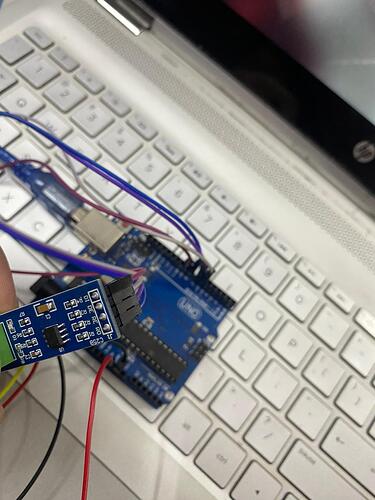#include <Arduino.h>
#define TAG "RS485_MODB_APP"
#define mod Serial2
#define TXD 17
#define RXD 16
#define RE 2
#define DE 4
#define BUF_SIZE 11
#define NITRO 0
#define PHOS 1
#define POTA 2
const uint32_t TIMEOUT = 500;
const byte moist[] = {0x3C, 0x61, 0x05, 0x11, 0xDD, 0xA4};
const byte temp[] = {0x01, 0x03, 0x00, 0x01, 0x00, 0x01, 0xD5, 0xCA};
const byte EC[] = {0x01, 0x03, 0x00, 0x02, 0x00, 0x01, 0x25, 0xCA};
//const byte PH[] = {0x01, 0x03, 0x00, 0x03, 0x00, 0x01, 0x74, 0x0A};
byte values[11];
void setup() {
// Serial.begin(9600);
Serial.begin(9600);
mod.begin(9600);
pinMode(RE, OUTPUT);
pinMode(DE, OUTPUT);
delay(500);
}
void loop() {
uint16_t val1, val2, val3, val4, val5, val6, val7;
Serial.println("Moisture: ");
val1 = moisture();
float Val1 = val1 * 0.1;
delay(1000);
//Serial.print(val1);
Serial.print(Val1);
Serial.println(" %");
Serial.println("-----");
//delay(1000);
Serial.println("Temperature: ");
val2 = temperature();
float Val2 = val2 * 0.1;
delay(1000);
//Serial.print(val2);
Serial.print(Val2);
Serial.println(" *C");
Serial.println("-----");
//delay(1000);
Serial.println("EC: ");
val3 = conductivity();
delay(1000);
Serial.print(val3);
Serial.println(" us/cm");
Serial.println("-----");
// Serial.println("Ph: ");
// val4 = ph();
// float Val4 = val4 * 0.1;
// delay(1000);
// //Serial.print(val4);
// Serial.print(Val4);
// Serial.println(" ph");
// Serial.println("-----");
delay(5000);
}
int16_t moisture() {
uint32_t startTime = 0;
uint8_t byteCount = 0;
digitalWrite(DE, HIGH);
digitalWrite(RE, HIGH);
delay(10);
mod.write(moist, sizeof(moist));
mod.flush();
digitalWrite(DE, LOW);
digitalWrite(RE, LOW);
startTime = millis();
while ( millis() - startTime <= TIMEOUT ) {
if (mod.available() && byteCount < sizeof(values) ) {
values[byteCount++] = mod.read();
printHexByte(values[byteCount - 1]);
}
}
Serial.println();
return (int16_t)(values[4] << 8 | values[5]);
}
int16_t temperature() {
uint32_t startTime = 0;
uint8_t byteCount = 0;
digitalWrite(DE, HIGH);
digitalWrite(RE, HIGH);
delay(10);
mod.write(temp, sizeof(temp));
mod.flush();
digitalWrite(DE, LOW);
digitalWrite(RE, LOW);
startTime = millis();
while ( millis() - startTime <= TIMEOUT ) {
if (mod.available() && byteCount < sizeof(values) ) {
values[byteCount++] = mod.read();
printHexByte(values[byteCount - 1]);
}
}
Serial.println();
return (int16_t)(values[4] << 8 | values[5]);
}
int16_t conductivity() {
uint32_t startTime = 0;
uint8_t byteCount = 0;
digitalWrite(DE, HIGH);
digitalWrite(RE, HIGH);
delay(10);
mod.write(EC, sizeof(EC));
mod.flush();
digitalWrite(DE, LOW);
digitalWrite(RE, LOW);
startTime = millis();
while ( millis() - startTime <= TIMEOUT ) {
if (mod.available() && byteCount < sizeof(values) ) {
values[byteCount++] = mod.read();
printHexByte(values[byteCount - 1]);
}
}
Serial.println();
return (int16_t)(values[4] << 8 | values[5]);
}
//int16_t ph() {
// uint32_t startTime = 0;
// uint8_t byteCount = 0;
//
// digitalWrite(DE, HIGH);
// digitalWrite(RE, HIGH);
// delay(10);
// mod.write(PH, sizeof(PH));
// mod.flush();
// digitalWrite(DE, LOW);
// digitalWrite(RE, LOW);
//
// startTime = millis();
// while ( millis() - startTime <= TIMEOUT ) {
// if (mod.available() && byteCount < sizeof(values) ) {
// values[byteCount++] = mod.read();
// printHexByte(values[byteCount - 1]);
// }
// }
// Serial.println();
// return (int16_t)(values[4] << 8 | values[5]);
//
//}
void printHexByte(byte b)
{
Serial.print((b >> 4) & 0xF, HEX);
Serial.print(b & 0xF, HEX);
Serial.print(' ');
}


